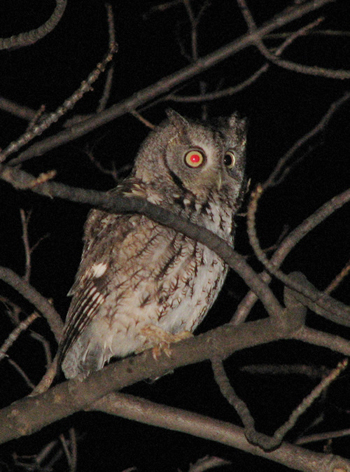The Deep Dark Forest – Is Alive!

screech owl
I had visited this patch of Allegheny River floodplain forest twice before during daylight hours, but some excitement was building now as I gathered my flashlights and other gear and walked off the dirt road to the edge of the trees. The summer night was warm and humid, and the darkness was punctuated with various patterns of flashing fireflies. That reminded me to look down to the ground, where before long I could also see the faint constant luminescence of a couple of firefly larvae or “glowworms” among the vegetation. Apparently, glowworms glow as a warning that they are poisonous; while as adults they flash as part of courtship. My eyes were slowly adjusting to the darkness, which was lightened only by faint starlight and a little light pollution from across the river.
Time for a look. I switched on my headlamp and the beam shot out into the tree trunks. Long ago I learned that a headlamp is better than a handheld flashlight. Not only does it free one’s hands for investigation and slapping occasional mosquitoes, it puts the source of light close to your eyes. The headlamp’s position right above the nose provides the observer with a better view and reflections. Certain animals, including many nocturnal mammals, owls, spiders and some moths, have reflective layers in the back of the eyes that increase the amount of available light for their vision. This layer also creates eyeshine.
After taking a few steps under the trees, I swept the light’s beam across the leaf litter for an example of that reflection, and within a few seconds there they were: wolf spider eyes! As non-webmaking forest floor predators, night vision is important to wolf spiders, and even though they are well camouflaged with shades of fallen-leaf brown, it is easy to find them at night at a surprising distance.
As I continued to look around I could see this night forest was wonderfully coming alive with daddy longlegs, ground beetles, leaf beetles, moths of various sizes floating past, more spiders, and more giant American millipedes (longer than my fingers) than I had ever seen in one place. There were a few toads on the prowl and some scurrying mice.
I came over a little rise and heard something larger running away through the shrubs, followed by the sound of claws on tree bark. Then appearing one, two, and three—twenty feet up in a large tree ahead of me and arranged vertically—were three sets of yellow blinking raccoon eyes peering back my way. I had to chuckle.
I turned my headlamp off and let my eyes adjust to darkness again. There were now a few crickets of different species chirping. Too early for the songs of katydids; those would come later in the summer. Just as I got back to the edge of the trees, my visit was topped off by a ruckus family of barred owls calling in unison behind me and sounding like they would continue partying even if I had to leave.
I love the forest at night, with all of its details and surprises. Find a friend or two and a couple flashlights and check it out for yourselves.
Charles Bier is the senior conservation scientist for the Western Pennsylvania Conservancy.
To hear an audio version of Charles Bier’s Field Notes visit iTunes to download free podcasts of his personal accounts and observations of Western Pennsylvania’s natural environment.
